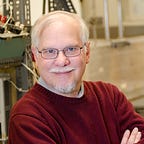Ask a paleontologist!
A few days ago, my news feed posted ‘Supernovae Could Be to Blame For Mass Extinctions on Earth, Study Shows.” Another site posted “END OF THE WORLD: Supernovae could cause MASS EXTINCTIONS on Earth warn scientists.” My attention caught, I went on to read the accompanying news articles and then to the original paper. Not unexpectedly, the actual research was far less dramatic. A 2016 paper suggested two supernova explosions had occurred within 100 parsecs (326 light years) of Earth in the ranges of 1.5–3.2 and 6.5–8.7 million years ago. The current paper in the journal Astrobiology, by Brian Thomas, models the impact of cosmic rays emitted by one of these supernovae on our ozone layer and by extension on the biosphere. He concludes that the biological impacts were not “mass-extinction level but might be expected to contribute to changes in species abundances.” Not exactly the end of the world!
I had multiple reactions to this story. My first was confirmation of my dislike of headlines. These were definitely misleading. To paraphrase something I once heard, scientists write detailed papers, press releases summarize the key points, and most people only see the hyperbolic headlines. Would anyone be interested in a headline that reads “Nearby Supernova Could Have Some Impacts on Life”?
My second reaction was a powerful sense of déjà vu. The idea that a supernova could be responsible for mass extinctions has been around for a half-century. Terry and Tucker first proposed that supernovae could cause extinctions in 1968; Russell and Tucker in 1971 specifically suggested that one may have caused the extinction of the dinosaurs. A 1976 review by Tucker gave a possible timeline for the impact of the blast, including the depletion of the ozone layer. As is often the case, these earlier papers seem to have been largely forgotten; perhaps buried by the explosion of papers on impacts that started in 1980.
My third reaction was to the scarcity of paleontological data in the paper. Only two works were cited; a 1997 paper by Kay Behrensmeyer and colleagues on Pliocene changes in the mammals of East Africa and a brief 2014 commentary by Pennington and Hughes on the late Miocene/Pliocene spread of the savanna biome. These shifts are given as support for a supernova influence on life around 2.5 million years ago. This is a pretty slender thread; the fossil record shows almost constant shifts in the biosphere at many scales; thus, almost any interval will show some change that will match a given event.
My overwhelming reaction, however, was to ask why didn’t Thomas reach out to paleontologists for comments or even collaboration? Why didn’t the editors have a paleontologist review the paper? There are plenty of specialists on the Miocene and Pliocene fossil record who could have been consulted. As the old saying goes, we are “in the phone book” (or can be Googled) and can easily be reached.
Which brings me back to another overwhelming sense of déjà vu and the major reason for this essay. There is a long history of specialists outside of paleontology publishing ideas about the history of life, especially about extinctions, without consulting with those who actually understand the nature and limitations of our data. Take, for example, self-organized criticality (SOC) and related “evolution models.”
Self-organized criticality, developed by the late Per Bak and his colleagues, is a group of very simple models that develop a fractal structure in both space and time. To Bak, it explained why these patterns were so ubiquitous in nature, to the extent he wrote a 1996 book about SOC entitled (modestly), How Nature Works. One characteristic of SOC models is that they are prone to rapid build-ups and crashes. a feature Bak and his collaborators compared to patterns in the fossil record, in particular mass extinctions. They also, unfortunately, equated the upswings to the “punctuated equilibrium” idea of Eldredge and Gould, which is a fundamental misunderstanding of that concept. Shortly afterwards, working independently, Jack Sepkoski and I, as well as Jim Kirchner and Anne Weil, showed that neither the data or the assumptions of SOC matched what we knew about the fossil record or the way that evolution worked.
That should have been the end to it. Unfortunately, over the next decade or so SOC gave birth within the physics community to a large family of “evolution models.” Nearly all of them misstated the concept of punctuated equilibrium, referred only to a single paper of Raup and Sepkoski for empirical support, and were sent to me for review (or so it seemed at the time). Virtually none were ever discussed with a paleontologist before being submitted. I finally informed journal editors that I was no longer willing to review these papers unless they showed a more than superficial understanding of the science they were trying to model or had at least reviewed their model with a paleontologist. The review requests stopped, but the models are still being published.
To be fair, not all those who worked on evolution models ignored the paleontologists; Mark Newman is an example of a physicist who was careful to make connections. And there have been other examples of fruitful connections across the disciplines; the paleontologist Bruce Lieberman worked closely with astronomers and physicists to assess whether a gamma ray burst caused the end-Ordovician extinction.
My goal here is not to blast Thomas or his paper; I am sure that he is highly qualified and that the atmospheric chemistry is solid. The actual claims in the paper were modest and carefully stated (as opposed to the headlines). Instead, my goal is to kvetch about why specialists in other areas of science seem so interested in paleontology, especially extinctions, but rarely seem to talk to a paleontologist. We know our science, are open to innovative ideas, and love collaborations. Ask us!
